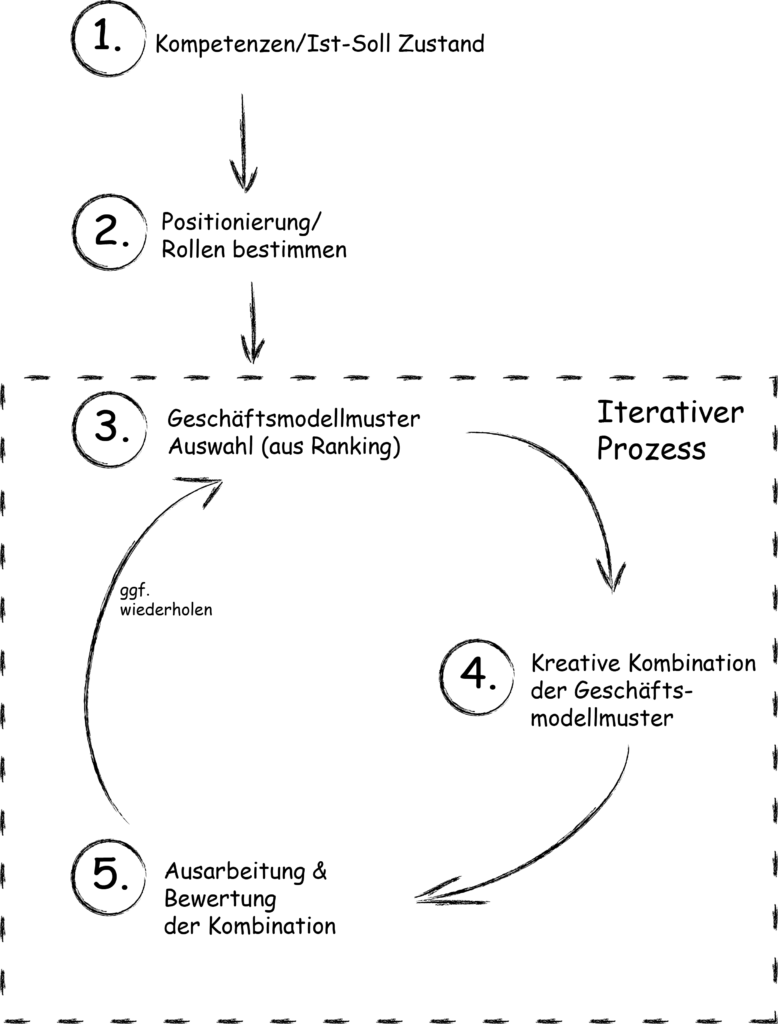How do I work with this tool?
First of all, the EPN supports companies in positioning themselves in a digital ecosystem. In addition, the tool offers assistance in identifying suitable business model samples that can be combined into a specific business model.
What are business model samples?
For the development of business models, it makes sense to work with business model samples instead of starting on a “greenfield site”. Business model samples are basic business model elements (or components) that describe the general functioning of a business model. In order to innovate existing business models or develop new ones, these business model patterns can be creatively combined with each other.
A comprehensive collection of business model samples was compiled by Oliver Gassmann, Karolin Frankenberger and Michaela Csik from the University of St. Gallen (Gassmann et al., 2013; Gassmann et al., 2017). This collection of business model samples was created in the context of a comprehensive scientific study, according to which about 90% of all new business models of various companies and industries are created by recombining existing concepts and technologies. In the course of this study, the scientists identified a total of 55 samples that form the core of many business models (Gassmann et al., 2013; Gassmann et al., 2017). One of the identified business model patterns is, for example, the “razor and blade” pattern, where customers can purchase a product very cheaply or free of charge (e.g. printers, shavers). However, the consumables required to use the product (e.g. printer cartridges, razor blades) must always be purchased in a suitable and relatively expensive manner.
For our EPN tool, we have analysed the 55 business model patterns mentioned above and classified them according to their immediate potential for exploitation for the various roles in the digital ecosystem (Mihale-Wilson & Kubach, 2019). The EPN thus takes advantage of the fact that different business model samples have a higher exploitation potential for certain roles in the digital ecosystem than for others. For example, the immediate exploitation potential of the “Razor and Blade” business model pattern is higher for hardware manufacturers than for information providers.
By using the EPN, companies can specifically identify those business model patterns that they should primarily deal with in the process of business model innovation or new development.
Five steps to the business model

In the section below, the procedure of the Ecosystem Participation Navigator is explained step by step. It comprises five steps in total:
- Identification of corporate competences
- Identification of the potential role(s) of your company in the digital ecosystem
- Identification of the business model samples with the highest exploitation potential
- Creative combination of business model samples
- Development and selection of suitable business models
Steps 3-5, represent an iterative process that can be repeated several times if necessary. For example, if a promising business model could not be developed in a first process iteration, a new process iteration must be restarted with step 3.
literature:
Gassmann, O., Frankenberger, K., & Csik, M. (2013). The St. Gallen Business Model Navigator, University of St. Gallen.
Gassmann, O., Frankenberger, K., & Csik, M. (2017). Geschäftsmodelle entwickeln: 55 innovative Konzepte mit dem St. Galler Business Model Navigator: Carl Hanser Verlag GmbH Co KG.
Mihale-Wilson, C., & Kubach, M. (2019). Business Models for Open Digital Ecosystems of Trustable Assistants. LNI, GI Edition Proceedings, „Open Identity Summit 2019“ (OID2019), Köllen, Germany.
